Description and Requirements
The Book
Bibliography
Syllabus
 Introduction
Introduction The Great Pyramid
The Great Pyramid Music of the Spheres
Music of the Spheres  Number Symbolism
Number Symbolism  Polygons and Tilings
Polygons and Tilings  The Platonic Solids
The Platonic Solids  Roman Architecture
Roman Architecture  Number Symbolism in the Middle Ages
Number Symbolism in the Middle Ages  The Wheel of Fortune
The Wheel of Fortune  Celestial Themes in Art
Celestial Themes in Art  Origins of Perspective
Origins of Perspective  What Shape Frame?
What Shape Frame?  Piero della Francesca
Piero della Francesca  Leonardo
Leonardo  Façade measurement by Trigonometry
Façade measurement by Trigonometry  Early Twentieth Century Art
Early Twentieth Century Art  Dynamic symmetry & The Spiral
Dynamic symmetry & The Spiral  The Geometric Art of M.C. Escher
The Geometric Art of M.C. Escher  Later Twentieth Century Geometry Art
Later Twentieth Century Geometry Art  Art and the Computer
Art and the Computer  Chaos & Fractals
Chaos & Fractals
Ad Quadratum,
the Sacred Cut, &
Roman Architecture
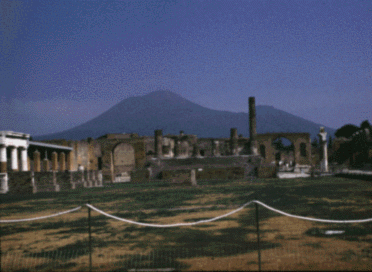
Slide 7-19: View of Pompeii with Mt. Vesuvius in the Background
Calter Photo
"Without symmetry and proportion there can be no principles in the design of any temple; that is, if there is no precise relation between its members, as in the case of those of a well shaped man."
Vitruvius, Book III, Chap. 1
| Outline: | Introduction |
| Vitruvius | |
| Ad Quadratum | |
| The Sacred Cut | |
| Roman Architecture | |
| Summary |
We leave ancient Greece now and move forward a few centuries to Rome. We'll start with a brief look at the architect Vitruvius, whose words echo down through the centuries.
When we discussed the polygons we looked at the triangle, pentagon, and hexagon, leaving the square and rectangle for this unit. We'll see here that the square and its diagonal, the so called ad quadratum, played a central role in Roman architecture.
Further, a geometric construction involving the square called the sacred cut also seems to have been used by the Romans. We'll see the sacred cut again when we discuss the octagon in the Middle Ages.
Finally we'll have a look at a particular rectangle, the so-called roman rectangle, thought to be central to the Roman's system of proportions.
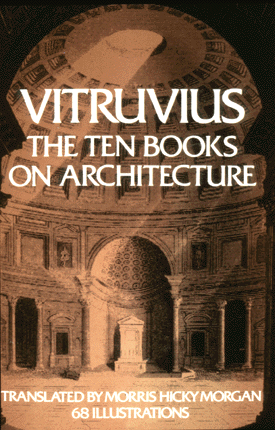 |
Slide 7-1: Vitruvius Cover
Vitruvius. The Ten Books on Architecture. NY: Dover, 1960. |
Vitruvius, whose full name is Marcus Vitruvius Pollio (70?-25 BC), was a Roman architect and engineer, born probably in Formiae (now Formie), Italy. He was an artillery engineer in the service of the first Roman emperor, Augustus.
The Ten Books on Architecture
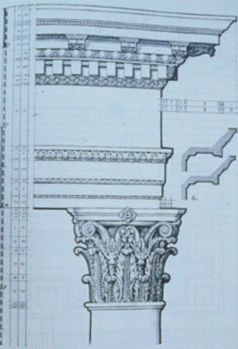 |
Slide 7-2: Corinthian Capital
Harris, Cyril. Illustrated Dictionary of Historic Architecture. NY: Dover, 1977. |
His ten books on architecture, De Architectura (trans. 1914), are the oldest surviving work on the subject. They consist of dissertations on a wide variety of subjects relating to architecture, engineering, sanitation, practical hydraulics, acoustic vases, and the like. Much of the material appears to have been taken from earlier extinct treatises by Greek architects.
Vitruvius's writings have been studied ever since the Renaissance as a thesaurus of the art of classical Roman architecture. It's in Vitruvius that we first see the classical orders of architecture, Doric, Ionic, Corinthian.
Vitruvian Man
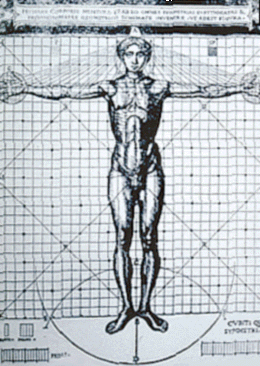 |
Slide 7-3: Vitruvian Man from Cesariano's edition of Vitruvius, 1521.
Wittkower, Rudolf. Architectural Principles in the Age of Humanism. NY:Random, 1965. Fig. 4. |
In the Old Testament, we read in Isaiah,
"The carpenter stretches a line, he marks it out with a pencil; he fashions it with planes, and marks it with a compass; he shapes it into the figure of a man, with the beauty of a man, to dwell in a house."
Echoing this idea, In Book III of his De architectura, Vitruvius writes,
"Without symmetry and proportion there can be no principles in the design of any temple; that is, if there is no precise relation between its members, as in the case of those of a well shaped man."
He goes on to say,
". . . if a man be placed flat on his back, with his hands and feet extended, and a pair of compasses centered at his navel . . . the fingers and toes of his two hands and feet will touch the circumference of a circle described therefrom. And just as the human body yields a circular outline, so too a square figure may be found from it. For if we measure the distance from the soles of the feet to the top of the head, and then apply that measure to the outstretched arms, the breadth will be found to be the same as the height . . ."
This paragraph has given rise to many pictures of men in squares and circles, so called Vitruvian men, some as illustrations to editions of his book, including the famous one by Leonardo. We'll talk about Vitruvian men again in our units on Squaring the Circle and Renaissance architecture.
The Need for a System of Proportions
Architects and builders have always sought systems of proportions, and Vitruvius was no different. He wrote, "Symmetry is a proper agreement between the members of the work itself, and relation between the different parts and the whole general scheme, in accordance with a certain part selected as standard."
And later, "Therefore since nature has proportioned the human body so that its members are duly proportioned to the frame as a whole, . . . in perfect buildings the different members must be in exact symmetrical relations to the whole general scheme".
Here Vitruvius uses symmetrical relationships to mean the same proportions, rather than some kind of mirror symmetry. Such a system would use the repetition of a few key ratios, to insure harmony and unity.
It would have additive properties, so the whole could equal the sum of its parts, in different combinations. This would give a pleasing design, and maintain flexibility. Finally, since builders are most comfortable with integers, it would be based on whole numbers.
Three Systems of Proportions
In this course we'll cover the three main systems of proportion in architecture.
- 1. A system based on the musical ratios, used by Alberti and Palladio, which we'll cover in our unit on Renaissance architecture.
- 2. A system based on the golden ratio, such as Le Corbusier's Modulor, which we'll look at in our unit on twentieth century architecture.
- 3. A system based on the square, apparently used by the Romans, the subject of this unit.
Ad Quadratum
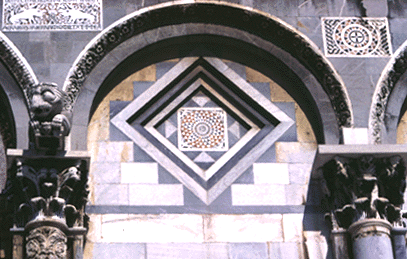 |
Slide 7-11: Pisa Duomo
Calter Photo |
Analysis of buildings at Pompeii and Herculaneum suggest that the design of the Roman house at all scales is based on the geometry of the square; they are said to be built ad quadratum.
The ad quadratum Figure
 |
Slide 7-8: Pavement at Herculaneum
Calter Photo |
In addition to underlying the ratios in some Roman buildings, this figure is often used for architectural decoration. I'll refer to this design, where one square is set diagonally inside another square, as the ad quadratum figure.
Root Two Rectangle
Vitruvius also mentions using the diagonal of a square as one way to find the dimensions of the atrium of a Roman house. ". . . by using the width [of the atrium] to describe a square . . . [and] drawing a diagonal in this square, and giving the atrium the length of this diagonal line."
The Sacred Cut
In addition to the ad quadratum figure and the root-two rectangle, we have a third geometric system based on the square. It is called the Sacred Cut.
Tons Brunes
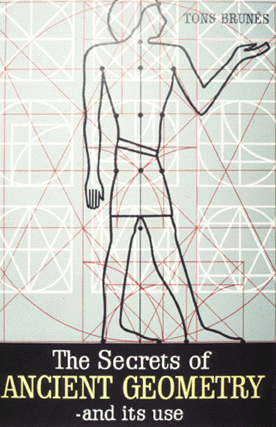 |
Slide 1-1: Secrets of Ancient Geometry and Its Use
Cover of Brunes' Book |
This name was coined by the Danish Engineer Tons Brunes, in his book The Secrets of Ancient Geometry and Its Use. In that book he claims the sacred cut is found in the layout of many ancient building, including the Parthenon.
The Sacred Cut
Here is how the sacred cut is made.
- Draw a square.
- With a compass open to an amount equal to half a diagonal of the square, swing an arc with center at a corner of the square, passing through the center of the square and cutting two sides of the square.
- Repeat for the other three corners of the square.
- Through the eight points of intersection of the arcs and the sides of the square, draw four verticals and four horizontals.
The center square formed by this construction is called the sacred cut square.
Connecting the eight points of intersection of the arcs and the sides of the square consecutively forms an octagon.
Extending the Construction
The construction can be extended inward, by repeating the construction on the sacred cut square.
It can also be extended outward, joining the intersections of the circles and the diagonals, to form a square of which the original square is the sacred cut square.
Why Sacred?
Brunes calls this construction sacred because it contains both square and circle, uniting the earthly and the divine as in the Vitruvian man.
Furthermore, it squares the circle. The length of the four arcs equal the four diagonals of the half-square.
And, as mentioned, it gives the octagon, the shape universally used for baptistries and baptismal fonts.
Roman Architecture
We've done some interesting constructions. But what does this have to do with actual Roman Buildings? We'll show here that measurements of certain Roman buildings have show a preference for certain ratios, and that these ratios are found in the same constructions we have just done.
The Eruption of Vesuvius
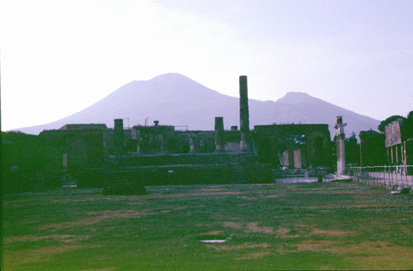 |
Slide 7-16: View of Pompeii with Vesuvius in Background
Calter Photo |
Let's first go to southern Italy in the first century of the current era, to the coast south of Naples. Here Mount Vesuvius (Italian Vesuvio, from Oscan word fesf, "smoke") rises to a height of 4190 feet, the only active volcano on the European mainland.
On August 24 in the year AD 79 Vesuvius, the top of the mountain was blown off and the cities of Pompeii, Herculaneum, and Stabiae were buried, not by lava, but by ashes and mud. About 2000 people were killed.
Pompeii
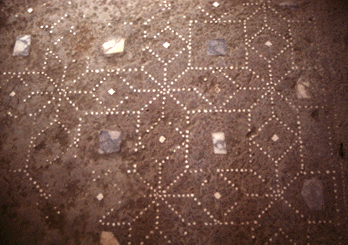 |
Slide 7-20: Floor Pattern from Pompeii
Calter Photo |
The mud went westward towards Herculaneum and the ash rained southeast and buried Pompeii, which lay undisturbed beneath the ashes for more than 1500 years. When excavations were started in 1748. it was seen how remarkably preserved everything was. The wet ashes and cinders had formed a hermetic seal about the town, preserving many public structures, temples, theaters, baths, shops, and private dwellings.
Herculaneum
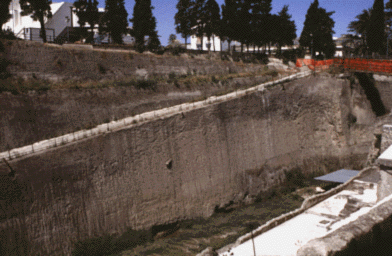 |
Slide 7-23: Herculaneum, showing the depth of the ashes
Calter Photo |
That same day Herculaneum was buried by mud about 65 ft deep. It is named for the person who, according to legend, founded the city; the mythical Greek Hercules. Like Pompeii it was a popular resort area for wealthy Romans.
Excavations of the ruins were begun at about the same time as at Pompeii. The diggers found many villas, a theater, marble and bronze sculptures, paintings, and a library of papyrus rolls in what was named the Villa of the Papyri, copied as the Getty Museum in Malibu.
House of the Tuscan Colonnade
Lets look at a single house in Herculaneum, The House of the Tuscan Colonnade. It was a typical house for the average patrician.
The ground plan drawn by Donald and Carol Watts shows the dimensions of the layout, in Oscan feet. (The Oscans were an early Italic people who lived in Campagna, the region around Naples. They built the original walls and towers of Pompeii and might have founded Herculaneum.) The dimensions found in the ground plan are:
| 5 | 12 | 17 | 29 | 41 |
Starting with 41 and calculate the sacred cut series
by dividing by ( 2 - 1)
or (1 -
2 - 1)
or (1 -  2/2) and rounding to integers,
the Watts' get the same numbers found in the house of the Tuscan Colonnade.
2/2) and rounding to integers,
the Watts' get the same numbers found in the house of the Tuscan Colonnade.
The Garden Houses of Ostia
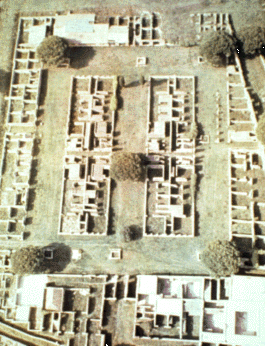 |
Slide 7-24: Aerial View of Ostia
Watts, Donald and Carol. A Roman Apartment Complex. Scien. Amer. Dec. 1986, p. 132-138. |
Another site studied by the Watts' is at Ostia, near Rome. There they found the ground plan to totally conform to the sacred cut construction. We refer you to their Scientific American article, in the bibliography, for more detail.
Summary
Did the Romans really use this stuff? The measurements at Pompeii and Herculaneum are fairly convincing, and those at Ostia quite compelling, that these proportions were used at least in those cases.
We saw that the desirability of using a system of proportions, rather that picking each dimension with no regards to the others in a structure, was clearly stated by Vitruvius. But its hard to say if the use of these particular proportions based on the square was more widespread, because we have no written record verifying their use. Here, Vitruvius is vague.
There are pragmatic reasons to use a worked-out system of proportions. It saves time and energy to have standard proportions. It requires fewer decisions for home buyers. It gave them something that was safe, standard, and conforming to the general tastes. Perhaps builders had style books, the way we do now.
It was an easy way to insure proportional relations without having to do calculations. All the constructions can be done with straightedge and compass, both done with stretched cord, so it was easy for an on-site layout. Just drive pegs and swing arcs.
Reading
Chitham, Robert. The Classical Orders of Architecture. (New York: Rizzoli International Publications, Inc., 1985).
Vitruvius. The Ten Books on Architecture. Trans. Morris Hickey Morgan. New York: Dover Publications, Inc., 1960.
Watts, Donald J. and Carol Martin Watts. "A Roman Apartment Complex," in Scientific American, vol. 255, no. 6 (December 1986) pp. 132-139.
Watts, Carol Martin. "The Square and the Roman House: Architecture and Decoration at Pompeii and Herculaneum," in Nexus: Architecture and Mathematics, Kim Williams, ed. (Fucecchio, Florence: Edizioni dell'Erba, 1996) pp. 167-181.
Watts, Donald J. and Carol Martin Watts. "The Role of Monuments in the Geometrical Ordering of the Roman Master Plan of Gerasa," Journal of the Society of Architectural Historians, LI, no. 3, September 1992, pp.306-314.
